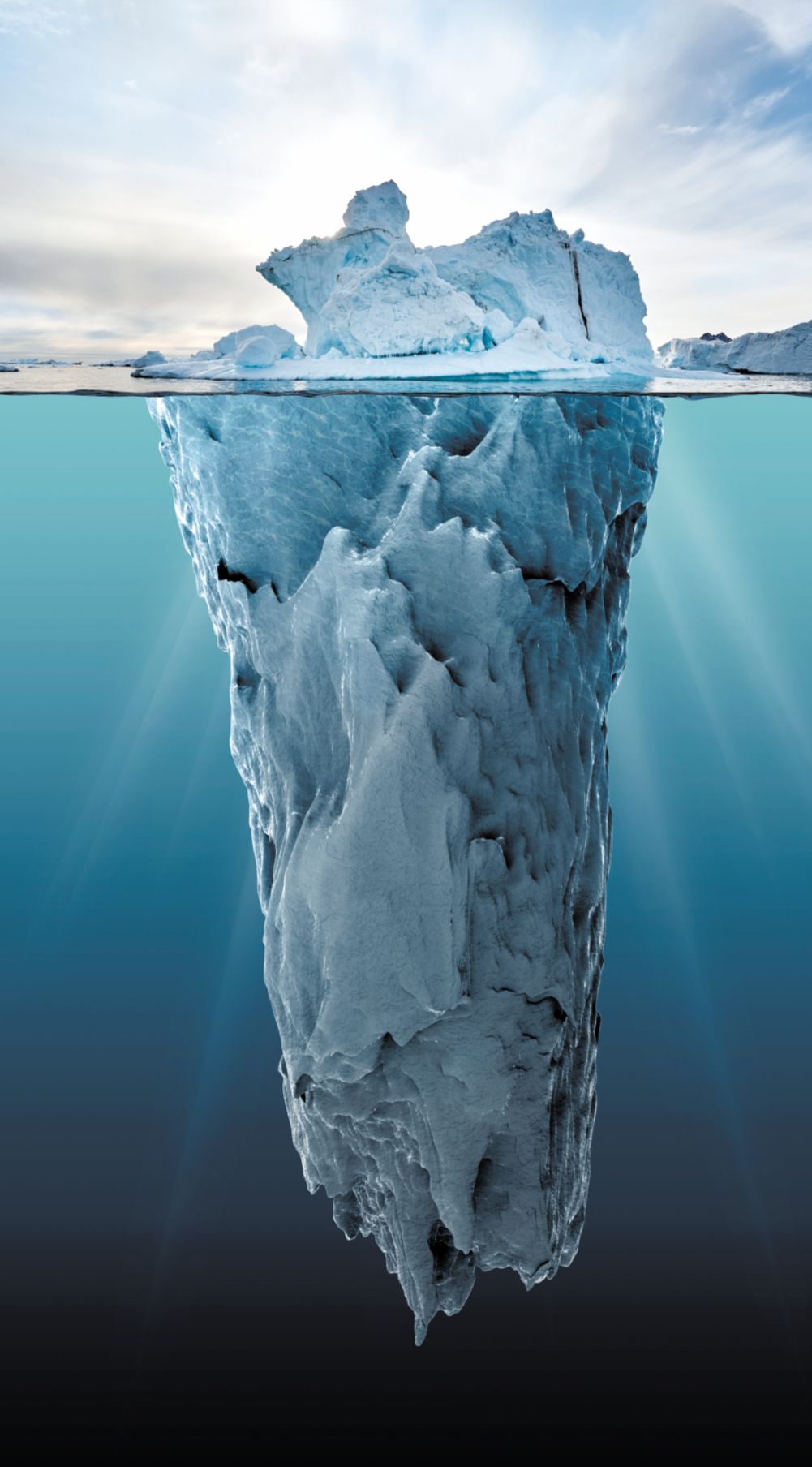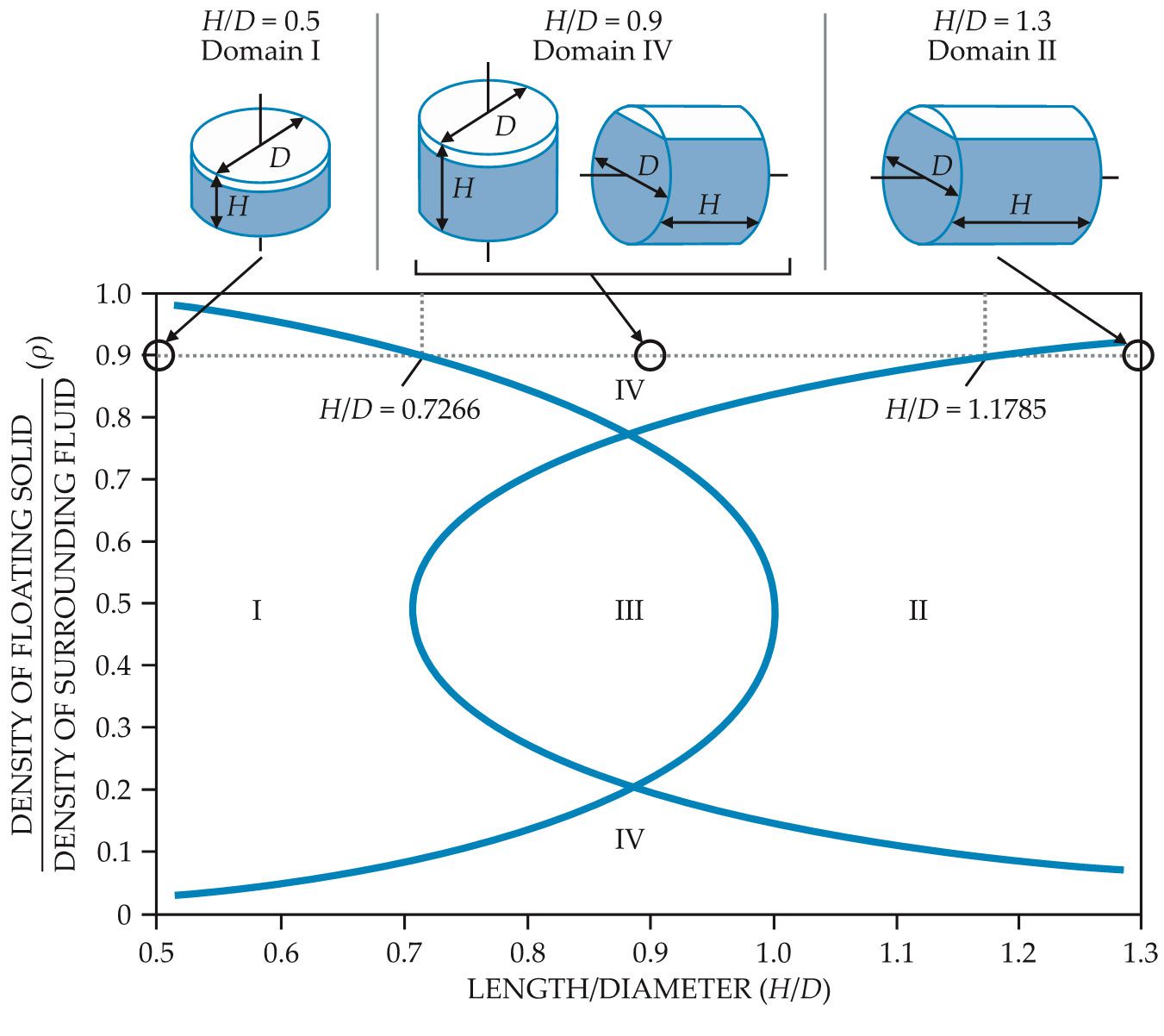Tip of the iceberg
DOI: 10.1063/PT.3.4373
The phrase “tip of the iceberg” suggests that what you see is much less than what is hidden from view. The concept of a tip above seawater and a much larger root below more or less conforms to Archimedes’s principle of buoyancy: The force exerted on a body partially or completely immersed in a fluid of higher density is directed upward and is equal to the weight of the fluid that the body displaces.
When a totally submerged lower-density body is released, the buoyancy force causes it to rise until it reaches a floating equilibrium. The tip then rests above the surface and the root below it, with the mass of each determined by the density contrast between the floating solid and the surrounding fluid. Figure
Figure 1.

An artistic rendition of a floating iceberg in apparent equilibrium. This orientation could never stably exist because an elongated piece of ice would float on its side, not on its head. (Image by iStock.com/the-lightwriter.)

Sphere, cube, and cylinder
What’s wrong with the image? A floating elongated iceberg can satisfy the buoyancy requirements of Archimedes’s principle in many orientations, but most, including that depicted in figure
An equilibrium orientation of a floating body occurs when the center of gravity (the center of mass of the whole object) and the center of buoyancy (the center of mass of just the submerged part) are vertically aligned. If perturbations from wind, waves, or melting lead to a small departure of that alignment, a torque is created that reorients the body. If the torque amplifies the misalignment, the orientation is unstable; if the torque reduces the misalignment, the orientation is stable.
What are the parameters that define a stable equilibrium orientation? A floating object must satisfy Archimedes’s principle by displacing a mass of fluid equal to its own. Because the object is less dense than the underlying fluid, it projects some volume above the surface and some volume below. Thus the first parameter that determines the stable equilibrium is the density contrast between the floating body and the surrounding fluid, here defined as a ratio
The density of ocean water depends on both temperature and salinity; the density of ice depends on ambient temperature and the concentration of bubbles and structural voids. But an ice–water density ratio of
The second important parameter is the shape of the floating body. Consider a floating sphere. Once its fractional volumes above and below the fluid surface have been established by the density contrast, it will float stably in any orientation. But a cubic body has well-defined stable orientations relative to the fluid surface that over a wide range of densities do not include the intuitive orientations—floating with a face or edge parallel to the fluid surface or with a corner pointing upward, perpendicular to the surface. To test that assertion experimentally, just place a cube of wood in water and let it stabilize.
How will an iceberg shaped like the one shown in figure
Figure 2. Domains of stability for floating cylinders. A plot of four stability domains is shown as a function of a cylinder’s shape 

The shape of stability
In 2004 D. S. Dugdale presented a useful discussion of the floating-cylinder problem. He defined four domains of stable equilibrium in density–shape space: (I) The cylinder floats with its rotational axis perpendicular to the water surface and its circular faces parallel to the water surface. (II) The cylinder floats with its rotational axis parallel to the water surface and its circular faces partially submerged to a depth dependent on the density of the cylinder. (III) The rotational axis of the cylinder is tilted at an angle neither parallel nor perpendicular to the surface. (IV) The orientations described in I and II are both stable.
Figure
In 1991 Edgar Gilbert showed that for a stable equilibrium with the cylindrical axis perpendicular to the water surface, the following condition must hold:
The width is determined by the density difference between the floating body and the fluid—that is, by how much of the cylinder is submerged. Gilbert showed that the equilibrium is stable if
References
► D. S. Dugdale, “Stability of a floating cylinder,” Int. J. Eng. Sci. 42, 691 (2004). https://doi.org/10.1016/S0020-7225(03)00237-4
► E. N. Gilbert, “How things float,” Amer. Math. Monthly 98, 201 (1991). https://doi.org/10.2307/2325023
► J. F. Nye, J. R. Potter, “The use of catastrophe theory to analyse the stability and toppling of icebergs,” Ann. Glaciol. 1, 49 (1980). https://doi.org/10.3189/S0260305500016955
► J. C. Burton et al., “Laboratory investigations of iceberg capsize dynamics, energy dissipations and tsunamigenesis,” J. Geophys. Res. Earth Surf. 117, F01007 (2012). https://doi.org/10.1029/2011JF002055
More about the Authors
Henry Pollack is an emeritus professor of geophysics at the University of Michigan in Ann Arbor.

